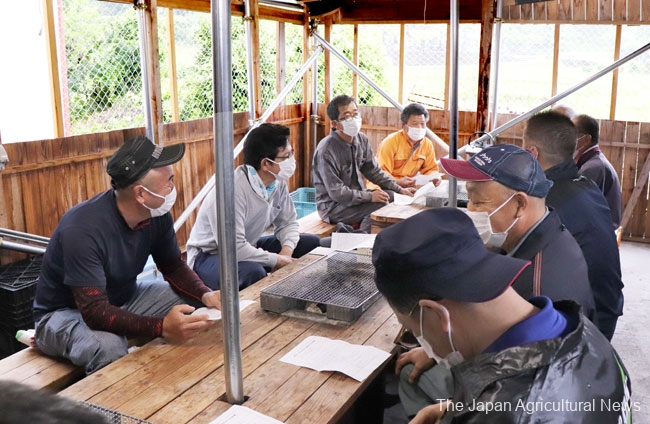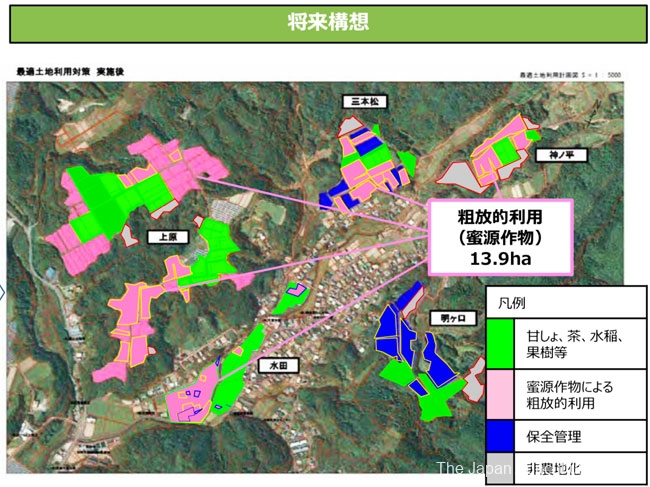
Yamasaki (third from the left) discussing mowing and planting nectar source crops with group members (in Makurazaki City, Kagoshima Prefecture)
KAGOSHIMA, TOYAMA, Sep. 7 – “Extensive management practices” are spreading in Japan as part of the initiatives to keep farmlands, preventing them from becoming abundant, with a small workload. In Kagoshima Prefecture, farmers and beekeepers turned unused farmlands into nectar sources. In Toyama Prefecture, farmers plan to change idle lands to pastures that require less money and work. The farm ministry of Japan started subsidizing such projects in fiscal 2021. People welcome the moves, saying “the initiatives are also improving the landscape,” though there are concerns about profitability. (Writer: Motoaki Omori)
“I’m looking forward to seeing our visitors’ smiling faces,” said Shoji Yamasaki, the 58-year-old chairman of “Yume-Hotaru Tabugawa 2016,” a group formed to stimulate the regional economy in Tabugawa, Makurazaki City, Kagoshima Prefecture. The team of farmers, corporate workers, and residents of the mountainous region use empty lands to grow bee-friendly seasonal flowers like astragalus, field mustard, and cosmos, which made the region popular among tourists.
Tobacco producers in the region also saw a decline due to the recent fall of the tobacco industry. A total of 13.9 hectares, or 40% of their fields, became abundant, and the damage caused by wild boars and other animals also increased. On the other hand, Hachimitsu Nishitarumizu Yohoen, an apiary in Minamikyushu City, Kagoshima Prefecture, was looking for a new honey source to increase the number of beehives after wintering. The Farmland Intermediate Management Institutions (farmland bank) matched them and helped the whole region devise a business plan for the extensive management of the idle tobacco fields.
In fiscal 2021, the district began receiving the subsidy to grow flowers on its 13.9-hectare empty farmlands. The governmental support covers 6.56 hectares, of which 1.5 hectares were already cultivated in fiscal 2021, and the same will be done this fiscal year. The seeds are plowed into the soil to reduce the work required for seeding next season.
The management cost, including mowing, will be around 900,000 yen annually. The subsidy covers half, while the group and the apiary cover the other half in equal shares. The subsidy, however, will end in fiscal 2025. The district, with a population of 234, is a marginal community with an aging rate of over 60%. Tsuyoshi Okizono (71), one of the group members and a member of the city council, said they want to develop local specialties using rapeseed and other local products and make the business profitable and sustainable before the subsidy ends. “We also hope to increase the number of people moving into our community,” he said.
In Tateyama Town, Toyoma Prefecture, locals and new town residents decided to keep leisure ponies and grow herbs, reusing 2.59 hectares of empty farmlands. It took nearly half a year for the town officials to encourage the resident through dialogues to support the community together. Sosaku Sakaguchi, 41, moved into the area from Tokyo with his family six years ago. He said it’s his dream “to make these desolate farmlands beautiful with the power of the community.”
The Ministry of Agriculture, Forestry and Fisheries (MAFF) subsidizes part of farmland management costs for up to five years through local governments and primary agricultural cooperatives (JA) to encourage optimal land use. Five regions in four cities and towns (four prefectures) received the subsidy in fiscal 2021. Eight regions in seven cities and towns (seven prefectures) are receiving the subsidies in fiscal 2022.

Map of Tabugawa, Makurazaki City, Kagoshima Prefecture in the future (plan): In the areas colored in pink, they plan to grow bee-friendly flowers to introduce extensive management. (Map created based on materials provided by MAFF)

